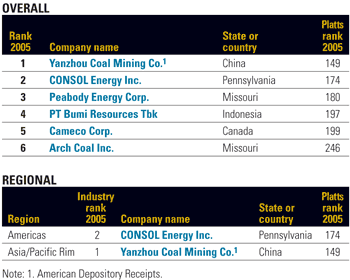...so domestic prices are surging
The US Energy Information Administration (EIA) recently raised its third-quarter price forecast for West Texas Intermediate (WTI) crude to $59.17/bbl and said monthly average WTI prices would remain above $55/bbl for the rest of this year and next—levels already surpassed. Imbalances, real or perceived, in domestic markets could cause light crude prices to average above $60/bbl, said the EIA, which is the statistical arm of the US DOE.
Among several factors contributing to the forecast of high crude prices, the EIA cited expected robust worldwide demand growth in 2005 and 2006. The agency said worldwide demand is projected to grow at an annual average rate of about 2.1-mil bbl/day to 85-mil bbl/day in 2005 and to 87.1-mil bbl/day in 2006. Production in countries outside OPEC is not expected to accommodate incremental demand growth, the EIA said.
Some look abroad; others stay home
Strategic moves by Los Angeles–based Occidental Petroleum (Oxy) exemplify how some companies are carving out their global positions. Libya's government and its National Oil Corp. agreed to allow Oxy to resume operations in four exploration blocks it was forced to abandon when then-US President Ronald Reagan forced all US oil companies to leave Libya more than 20 years ago. The US lifted sanctions against Libya in April 2004.
Oxy expected the deal to immediately add net production of up to 15,000 bbl/day. Oxy CEO Ray Irani claimed Libya "holds significant potential for future production growth through new investment in enhanced oil- recovery projects." Oxy and partners also hold deals with Libya's NOC for nine exploration blocks awarded in January 2005.
Separately, Oxy and the United Arab Emirates' Mubadala Development struck a production-sharing agreement with Oman, giving Oxy 45% of the Mukhainza oilfield project. Oxy and Mubadala take over operations from Royal Dutch Shell, which had run the project since 2000.
Oxy plans to spend $2-bil for enhanced recovery (primarily using steam injection) to boost production to 150,000 bbl/day by 2010 from the current 10,000 bbl/day. Oxy expects to recover an estimated 1-bil barrels over the 30-year life of the agreement.
Oxy reorganized in early 2005, dividing its oil and gas operations into two divisions—western hemisphere and eastern hemisphere—with the head of each unit reporting directly to Irani. "This realignment will enhance the ability of each organization to focus on optimizing production and competing successfully for new growth opportunities which are unique to each region," he said. Outside North America, Oxy's main areas of oil and gas operations are in Colombia, Ecuador, Peru, Libya, Oman, Qatar, and Yemen.
As another example, Canada's Imperial Oil plans to spend up to $5.4-bil to develop its 4.4--bil-barrel bitumen Kearl Oil Sands Project in Alberta. The joint venture with ExxonMobil Canada could begin in 2007, with bitumen production starting in 2010 at 100,000 bbl/day. Subsequent development in 2012 and 2018 could bring production to about 300,000 bbl/day.
Imperial is also deeply involved in the Mackenzie Gas Project, an effort to open Arctic natural gas reserves. Imperial and Mackenzie partners ConocoPhillips Canada, Shell Canada, and ExxonMobil Canada think that by the end of the decade they can start moving some 1.2-bil cubic feet/day from three Mackenzie Delta fields, which has estimated reserves of almost 6 trillion cubic feet.
Leaders—coal and combustible fuels

Source: Platts
Other North American companies are looking south. Valero LP, the midstream logistics partnership owned partially by independent refiner Valero Energy, signed a deal with Mexico's national oil company, Pemex, to build 110 miles of pipeline with the capacity to ship 32,000 bbl/day of oil products from Mexico across the border to Brownsville, Texas. In a separate agreement, Valero Marketing and Supply, a subsidiary of Valero Energy, will supply Pemex trading arm PMI with 10,000 bbl/day of liquefied petroleum gas (LPG). Pemex holds a 10-year agreement to ship products on the line, which is slated to begin service in mid-2006.
Valero's CEO, Bill Greehey, characterized the fundamentals for refined products as "outstanding," reflecting strong demand for gasoline, distillate, and petrochemical feedstocks. "Growing global demand for distillate as a transportation fuel has caused on-road diesel and jet fuel to become more of an equal partner with gasoline on a margin basis. Clearly, the refining industry has entered a new era," he said.
Meanwhile, EnCana President and CEO Gwyn Morgan said his company is focused on North America, particularly "long-life," low-decline natural gas plays. Overall, EnCana, one of the largest North American independent oil and gas companies, is moving to increase spending while cutting costs. Daily gas sales approach 3.25-bil cubic feet/day and are forecast by the company to grow in the years ahead. By year-end 2005, gas sales could reach 3.7 bcf/day.
EnCana Oil & Gas (USA) Inc. Executive Vice-President and President Roger Biemans said the company is selling off "conventional" assets in favor of "unconventional" onshore activity in Canada and the US, particularly the Rocky Mountain region. To EnCana, unconventional means tight gas sands, gas shale, in-situ oil sands, subvolcanic plays, and others.
EnCana will soon jettison its natural gas storage network, believed to be the largest on the continent, with a value estimated at $900-mil. It includes facilities in Alberta, Oklahoma, and California, mainly in underground aquifers.
Moscow-based Gazprom Rao claims to be the world's largest producer and exporter of natural gas through its export unit, Gazpromexport. Gazpromexport annually provides some 4.6 Tcf to 28 countries, including over 25% of the natural gas consumed in Europe. According to Alexander Medvedev, deputy chairman of Gazprom's management committee and director general of Gazpromexport, the company plans to increase export volumes while expanding the geography and product range, particularly liquefied natural gas (LNG).
"Gazprom is committed to being a long-term leader in the world LNG market," said Medvedev. The strategy is simple, he said: "We want to be involved in all parts of the value chain. For access to our strategic reserve base, we want equal access to the downstream and midstream assets" in the lNG industry outside Russia.